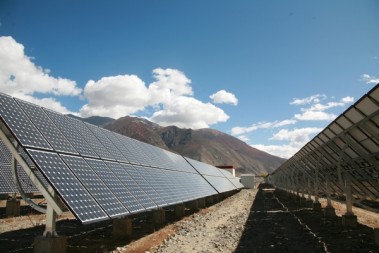Suntech has similar operations at a new plant in Arizona. Until last year, Suntech and other Chinese solar companies shipped virtually all their products overseas. The influx of cheap solar panels has been blamed for troubles in the U.S. industry. In fact, Suntech is one of three Chinese panel makers being sued by the failed Fremont company, Solyndra, for unfair competition. But now China’s central government has launched a major initiative to jumpstart its own use of solar energy.
Last year, the central government began subsidizing solar power projects. This year alone, China will have installed about 5 gigawatts of capacity, producing enough electricity to supply two million Chinese. That’s about a third more capacity than the U.S. is set to install this year. Although China’s build-out barely puts a dent in its carbon footprint -- the biggest in the world -- Chinese solar companies and environmentalists are encouraged.
“It took China a while to bring its solar program up to speed,” says Andrew Beebe, a Suntech executive based in San Francisco. “And now that it's really up to speed, it’s cranking.”
The Magic of the Feed-in Tariff
That would be thanks to a subsidy known as a feed-in tariff. It’s a subsidy for renewable energy that guarantees developers of these projects a reasonable return on their investments. The government pays developers a certain price per kilowatt-hour to entice them to install solar.
China’s feed-in tariff is actually mimicking similar programs in Europe and the U.S. to promote wind and solar power. Alvin Lin is with the Beijing office of the American environmental group, NRDC. He says, “The feed-in tariffs are really pretty amazing policy tool for incentivizing renewable projects. “
The Chinese program, like the European model, promotes large, utility-scale solar projects. Rooftop installations are still relatively rare in China.
The Timing
So why the subsidy now? There are a host of reasons. As one of China’s numerous new bullet trains blows into a station, I’m reminded of a big one. This one whisked me from Beijing to Shanghai -- like going the full length of the California coast -- in just 5 hours. China needs electricity to power its transportation needs. The nation also needs electricity for new factories and appliances bought by its growing middle class.
China still gets about 70 percent of its power from coal, virtually all of it mined domestically until recently. The growing demand for electricity has outpaced even this country’s coal production.
When China became net importer coal, “That surprised everybody,” says Yang Fuqiang, an energy expert in NRDC’s Beijing office. Yang says to offset this dependence on coal, both domestic and foreign, China wants to diversify its energy mix. “So the Chinese government says we have to save our resources.”
And save its environment from the effects of burning all this coal, including prodigious carbon emissions. China is now the world’s biggest contributor to global warming.
China’s Ambitious Plans for Renewables
So the central government has set an ambitious goal: to produce more than 11 percent of China’s energy from non-fossil fuels by the end of the decade. That’s slightly less than what renewables now account for in U.S. electricity production.
In the meantime, “You know, pain for companies is inevitable in a market that is about 60 percent oversupplied this year,” says Nathaniel Bullard, an analyst at Bloomberg New Energy Finance in San Francisco. Suntech’s share price, for instance, has plummeted from a high of about $90 four years ago, to less than a buck now. Bullard will be watching whether the China Development Bank bails out some solar companies. If so, he says, “It would start to look like the kind of issue that could inflame this trade case even further.”
However that shakes out, China’s solar sector will still provide strong competition for firms in California and across the U.S. Beijing has already declared that by 2015, it will quadruple this year’s solar installation.
But watching Chinese throng a gigantic, glittering shopping center in downtown Shanghai, one sees a microcosm of an enormous challenge: thirteen floors filled with the latest fashions and trendy restaurants. No matter how ambitious China’s solar program, it’s up against hundreds of millions of people striving for a more “Western” lifestyle, and that will create the need for ever-more megawatts to power the trappings of middle-class living. The race for power is on.
